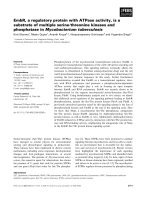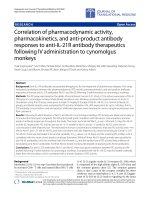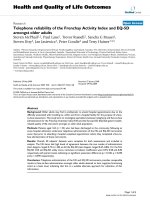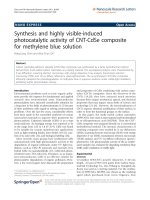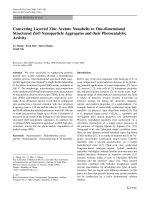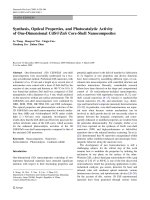NIR responsive photocatalytic activity (980nm and 794nm) of NaYF4 YB, tm tio2 and NaYF4 yb, tm, NdNaYF4 nd tio2 colloidal spheres
Bạn đang xem bản rút gọn của tài liệu. Xem và tải ngay bản đầy đủ của tài liệu tại đây (3.34 MB, 93 trang )
NIR-responsive Photocatalytic Activity (980 nm and
794 nm) of NaYF4:Yb, Tm-TiO2 and NaYF4:Yb, Tm,
Nd@NaYF4:Nd-TiO2 Colloidal Spheres
WANG YANQI
NATIONAL UNIVERSITY OF SINGAPORE
2014
NIR-responsive Photocatalytic Activity (980 nm and
794 nm) of NaYF4:Yb, Tm-TiO2 and NaYF4:Yb, Tm,
Nd@NaYF4:Nd-TiO2 Colloidal Spheres
WANG YANQI
(B.Sc., PEKING UNIVERSITY)
A THESIS SUBMITTED
FOR THE DEGREE OF MASTER OF
SCIENCE
DEPARTMENT OF CHEMISTRY
NATIONAL UNIVERSITY OF SINGAPORE
2014
Declaration
I hereby declare that this thesis is my original work and it has been written by
me in its entirety, under the supervision of LIU XIAOGANG, (in the
laboratory S8-05-13), Chemistry Department, National University of
Singapore, between Aug. 2013 and July 2014.
I have duly acknowledged all the sources of information which have been used
in the thesis.
This thesis has also not been submitted for any degree in any university
previously.
Wang Yanqi
Name
Signature
Date
I
II
ACKNOWLEDGEMENT
During the past year in NUS, I have had a lot of memorable experiences
and learned many useful knowledge. I would like to thank all the professors,
mentors, colleagues and friends who helped and supported me.
Foremost, I want to give my deep and sincere gratitude to my supervisor,
Professor Xiaogang Liu, whose wide knowledge, detailed review, and
constructive comments have greatly improved and expanded the scope of this
thesis. His rigorous scholarship, eruditeness with a keen scientific insight and
boundless enthusiasm for scientific work will deeply influence me on my life.
I will never forget that he teach us how to practice and improve our English
skills on the group meeting.
I would like to give my great thanks to all the members in the Liu’s group.
Dr. Xiaoji Xie, Dr. Renren Deng, Dr. Xiyan Li, Dr. Yu Wang, Dr. Bo Zhou, Dr.
Qianqian Su, Mr. Xiaowang Liu, Mr. Sanyang Han, Mr. Qiang Sun, Mr. Yuhai
Zhang, Ms. Xian Qin, Ms. Jing Tian, Mr. Guojun Du, Mr. Xiao Zeng, Ms.
Jiahui Xu. Thank you all for your help.
I would like to sincerely acknowledge the financial support of National
University of Singapore, and the SPORE program. I would like to thank all the
members in the SPORE program.
III
IV
Table of Contents
Declaration ................................................................................................................... I
ACKNOWLEDGEMENT ......................................................................................... III
SUMMARY ............................................................................................................... VII
LIST OF FIGURES ................................................................................................... IX
LIST OF ABBREVIATION AND SYMBOLS ..................................................... XIII
CHAPTER 1: Introduction ........................................................................................ 1
1.1 Introduction of Nanomaterials ............................................................................ 1
1.2 Optical Property of Upconversion Nanoparticles ............................................... 3
1.3 Photocatalysis of Titanium Dioxide .................................................................... 9
1.4 The Integration of Upconversion Materials and Titanium Dioxide .................. 15
1.5 Objectives ......................................................................................................... 17
CHAPTER 2: NIR-responsive Photocatalytic Activity (980 nm) of NaYF 4: Yb,
Tm-TiO2 Colloidal Spheres ...................................................................................... 18
2.1 Introduction ....................................................................................................... 18
2.2 Synthesis and Characterization ......................................................................... 23
2.2.1 Materials .................................................................................................... 23
2.2.2 Characterization ......................................................................................... 24
2.2.3 Synthesis of NaYF4: Yb3+, Tm3+ Nanoparticles ......................................... 25
2.2.4 Synthesis of Titanium Dioxide Nanoparticles ........................................... 26
2.2.5 Synthesis of NaYF4: Yb3+, Tm3+-TiO2 Hybrid........................................... 26
2.3 Experimental Design ......................................................................................... 27
2.3.1 Photocatalytic Experiments........................................................................ 27
2.3.2 Detection of Photogenerated OH Radicals ................................................ 28
2.4 Results and Discussion ..................................................................................... 29
2.4.1 The Optimal Synthesis Conditions ............................................................ 29
2.4.2 Characterization ......................................................................................... 35
V
2.4.3 The Upconversion Emission Property of NaYF4:Yb,Tm-TiO2 Colloidal
Spheres ................................................................................................................ 39
2.4.4 NIR-responsive Photocatalytic Activity (980 nm) of NaYF4: Yb, Tm-TiO2
Colloidal Spheres ................................................................................................ 42
2.5 Summary and Prospect ..................................................................................... 46
CHAPTER 3: NIR-responsive Photocatalytic Activity (794 nm) NaYF4:Yb, Tm,
Nd@NaYF4: Nd -TiO2 Colloidal Spheres ............................................................... 47
3.1 Introduction ....................................................................................................... 47
3.2 Synthesis and Characterization ......................................................................... 50
3.2.1 Materials .................................................................................................... 50
3.2.2 Characterization ......................................................................................... 50
3.2.3 Synthesis of NaYF4: Yb3+, Tm3+, Nd3+ Nanoparticles ............................... 52
3.2.4 Synthesis of NaYF4:Yb/Tm/Nd@NaYF4:Nd Core-Shell Nanoparticles ... 52
3.2.5 Synthesis of Titanium Dioxide Nanoparticles ........................................... 53
3.2.6 Synthesis of NaYF4:Yb/Tm/Nd@NaYF4:Nd -TiO2 Hybrid ...................... 54
3.3 Photocatalytic Experiments .............................................................................. 54
3.4 Results and Discussion ..................................................................................... 55
3.4.1 Characterization ......................................................................................... 55
3.4.2 The Upconversion Emission Property of NaYF4:Yb, Tm, Nd@NaYF4:
Nd-TiO2 colloidal spheres................................................................................... 58
3.4.3 NIR-responsive Photocatalytic Activity (794 nm) of NaYF4: Yb, Tm-TiO2
Colloidal Spheres ................................................................................................ 62
3.5 Summary and Prospect ..................................................................................... 63
CHAPTER 4: Conclusions and Future Work ........................................................ 65
References .................................................................................................................. 68
VI
SUMMARY
The fundamental researches on photocataiysis have drawn much attention
in recent years. The application of photocatalytic materials in solar energy
transfer and pollutants degradation provides a very promising method in
solving energy crisis and environment pollution. Among all these
photocatalysts, titanium dioxide have been widely studied and applied in
practice due to its physical stability, low cost, and high photocatalysis
efficiency. However, the solar energy utilization efficiency of typical TiO2
materials is constrained by its high possibility of electron-hole recombination
and large band gap. In order to enhance the photocatalytic efficiency and solar
energy utilization rate of TiO2, modification of titanium dioxide have been a
hot research topic.
This study fabricated two new kinds of photocatalyst (NaYF4: Yb,
Tm-TiO2
and
NaYF4:Yb/Tm/Nd@NaYF4:Nd-TiO2
colloidal
spheres)
successfully for NIR-responsive photocatalysis. The optimal synthesis
conditions and doping concentration of rare earth ions for the new materials
are established. TEM and XRD analysis confirm this 3D colloidal spheres
structure. UV light energy emitted from upconversion materials has been
utilized by this material to generate photo-generated electron-hole pairs, which
VII
then combine with the surface water or hydroxyl to generate sufficient amount
of •OH for photocatalytic degradation of organic pollutants. These new
materials present very good photocatalytic activity and could enhance
utilization efficiency for solar energy. NaYF4:Yb/Tm/Nd@NaYF4:Nd-TiO2
colloidal spheres can not only utilize 794 nm light but also 980 nm light when
irradiated by solar light. More importantly, this new material can avoid energy
consumption by water and consequent heating effect under 980 nm excitation.
More than 85% MB can be degraded by these two materials (25 oC, 4 h, 2 g/L
photocalysts), which confirms them good potential for photcatalytic
application.
VIII
LIST OF FIGURES
Figure 1.1 Proposed upconversion mechanisms for Yb3+-Tm3+ and Yb3+-Er3+
couples under 980 nm diode laser excitation. The dash-dotted, dashed ,dotted,
and full arrows represent photon excitaiton, energy transfer, multiphonon
relaxation, and emission processes, respectively ............................................. 5
Figure 1.2 Typical upconversion processes. (a) 2-photon absorption (TPA). (b)
Second-harmonic generation (SHG). (c) Cooperative sensitization. (d)
Cooperative luminescence. (e) Excited state absorption (ESA). (f) Energy
transfer upconversion. (g) Photon avalanche (PA). (h) Energy
migration-mediated upconversion (EMU). (Reprinted with permission. 10
Copyright 2013, Nature Publishing group.) .....................................................8
Figure 1.3 TiO2 photocatalysis mechanism .................................................... 12
Figure 1.4 Schematic energy level of iron doping TiO2 (Reprinted with
permission from 14 Copyright 2013, American Chemical Society.) ................ 14
Fig. 1.5 (a) A photo comparing TiO2 (left) and H-doped TiO2 (right); (b)
Spectral absorbance of TiO2 and H-doped TiO2; (c) HRTEM images of
H-doped TiO2 nanocrystals and (d) Schematic illustration of the DOS of
H-doped TiO2, as compared to that of unmodified TiO2 (From 15. Reprinted
with permission from AAAS) .......................................................................... 15
Figure 2.1 Solar energy distribution ............................................................... 19
Figure 2.2 Molecular formula of methylene blue ........................................... 24
Figure 2.3 schematic diagram of the equipment for photocatalytic experiments
.......................................................................................................................... 28
Figure 2.4 Influence of Yb concentration to the intensity of emission peak at
347 nm ............................................................................................................. 30
Figure 2.5 Influence of Tm concentration to the intensity of emission peak at
347 nm ............................................................................................................. 30
IX
Figure 2.6 TEM images of (a) NaYF4, (b) NaYF4 colloidal spheres, (c) TiO2,
(d) TiO2 colloidal shperes ................................................................................ 36
Figure 2.7 Upconversion emission spectra of NaYF4 :Yb, Tm nanoparticles
(Y solid) and NaYF4:Yb, Tm colloidal spheres (Y hybrid solid) under
excitation by a 980 nm continuous-wave (CW) laser ...................................... 37
Figure 2.8 TEM image (a) of NaYF4: Yb, Tm-TiO2 colloidal shperes and
HRTEM image (b) of aYF4: Yb, Tm-TiO2 colloidal shperes (inset: EDS
spectra of NaYF4: Yb, Tm-TiO2 colloidal shperes) ......................................... 38
Figure 2.9 XRD patterns of NaYF4: Yb, Tm nanoparticles and NaYF4: Yb,
Tm-TiO2 colloidal spheres (Y-Ti hybrid) ........................................................ 39
Figure 2.10 UV-vis absorption spectra of TiO2, NaYF4:Yb, Tm and
NaYF4 :Yb, Tm-TiO2 colloidal spheres (hybrid) ............................................. 40
Figure 2.11 Upconversion emission spectra of NaYF4:Yb, Tm nanoparticles
(Y solid), NaYF4:Yb, Tm+TiO2 colloidal spheres (Y+Ti hybrid solid), and
mix material of NaYF4:Yb, Tm and TiO2 (Y+TiO2 mix) under excitation by a
980 nm continuous-wave (CW) laser .............................................................. 41
Figure 2.12 Time-dependent fluorescence spectra of the terephthalic acid
solution under a 980 nm continuous-wave (CW) laser irradiation .................. 44
Figure 2.13 NIR photocatalytic activity of NaYF4:Yb,Tm, TiO2, mix material
of NaYF4 :Yb, Tm and TiO2, and NaYF4: Yb, Tm+TiO2 colloidal spheres
(980 nm). (2 g/L, 15 mg/L Methylene Blue) ................................................... 45
Figure 3.1 Water absorption spectra in vis-NIR region .................................. 48
Figure 3.2 (a) Schematic design (top) and simplified energy level diagram
(bottom) of a core-shell nanoparticle for photon upconversion under 800 nm
excitation. Nd3+ ions doped in the core and shell layers serve as sensitizers to
absorb the excitation energy and subsequently transfer it to Yb3+ ions. After
energy migration from the Yb3+ to activator ions, activator emission is
achieved via the Nd3+-sensitization process. (b) Near-infrared absorption
spectra of the NaYF4:Yb/Nd(30/1%) nanoparticles coated with an inert NaYF4
shell and an active NaYF4:Nd(20%) shell, respectively. Note that the
absorption spectra were normalized at 976 nm for comparison ...................... 49
X
Figure
3.3
TEM
images
of
(a)
NaYF4:Yb/Tm/Nd,
(b)
NaYF4:Yb/Tm/Nd@NaYF4:Nd ....................................................................... 56
Figure 3.4 XRD patterns of NaYF4 and NaYF4:Yb, Tm, Nd@NaYF4:
Nd-TiO2 colloidal spheres (hybrid) ................................................................. 57
Figure 3.5 Proposed energy transfer mechanisms under 794 nm CW laser
excitation in NaYF4 nanoparticles doped with Yb/Tm/Nd. The dashed-dotted,
dashed, dotted, and full arrows represent photon excitation, energy transfer,
multiphonon relaxation, andemission process, respectively. For clarity, only
dominated energy transfer processes are shown in the proposed mechanisms
.......................................................................................................................... 58
Figure 3.6 Upconversion emission spectra of NaYF4:Yb, Tm, Nd@NaYF4:
Nd under 980 nm excitation, 794 nm excitation, and 980 nm+794 nm
excitation ........................................................................................................ 59
Figure 3.7 Upconversion emission spectra of NaYF4:Yb, Tm, Nd@NaYF4:
Nd (Y-Nd solid) and NaYF4:Yb, Tm, Nd@NaYF4: Nd-TiO2 colloidal spheres
(Y-Nd+Ti solid) under excitation by a 980 nm continuous-wave (CW) laser
.......................................................................................................................... 60
Figure 3.8 Upconversion emission spectra of NaYF4:Yb, Tm, Nd@NaYF4:
Nd (Y-Nd solid) and NaYF4:Yb, Tm, Nd@NaYF4: Nd-TiO2 hybrid (Y-Nd+Ti
solid) under 794 nm excitation ........................................................................ 61
Figure 3.9 NIR photocatalytic activity of NaYF4:Yb/Tm,/Nd@NaYF4:Nd,
TiO2, mix material of NaYF4:Yb/Tm/Nd@NaYF4:Nd and TiO2, and
NaYF4:Yb/Tm/Nd@NaYF4: Nd-TiO2 colloidal spheres (794 nm) ................. 63
XI
XII
LIST OF ABBREVIATION AND SYMBOLS
CW
continuous wave
EMU
energy migration-mediated upconversion
ETU
energy transfer upconversion
ESA
excited-state absorption
PA
photon avalanche
SDS
sodium dodecyl sulfate
SPECT single-photon emission computed tomography
TEM
transmission electron microscope
XRD
X-ray diffraction
MB
Methylene Blue
XIII
CHAPTER 1
CHAPTER 1: Introduction
Since the formation of human civilization, the development of human
society is accompanied by acquirement and utilization of natural resources.
The current global economy relied on energy provided by oil, coal, and natural
gas as well as resources extracted from minerals. Predatory consumption of
traditional non-renewable resources caused energy crisis of human society
accompanied with destruction and pollution of the natural environment. In the
twenty-first century, "energy crisis" and "environment pollution" have become
the two critical constraints to sustainable development of human society.
Photocatalysis through solar light can be a very promising method in solving
these two problems 2.
1.1 Introduction of Nanomaterials
Nanomaterials have drawn much attention since their first studies in
1970s~1980s. Generally, the size of nanomaterials is between the range of 1 ~
100 nm in at least one dimension. With this nanoscale range between
microscopic and macroscopic, nanomaterials show specific surface and
interface effects, small size effect, quantum size effect and macroscopic
quantum tunneling effect, which make them exhibit excellent mechanical,
thermal, optical and electrical properties. Therefore, nanomaterials have broad
1
CHAPTER 1
applications in materials, medicine, biotechnology and environmental
protection. Moreover, nanoparticles now have been incorporated in our daily
life. More than one thousand nanoparticle-related products are now
commercially available, including health care products, electronic products,
and food products and so on 3.
Based on the spatial dimension, nanomaterials can be divided into zero
-dimensional clusters and nanoparticles, one-dimensional multi-layer films
and nanotubes (nanorods, nanowires), two-dimensional and three-dimensional
nanofilms and assembly material. Zero-dimensional nanomaterials include
TiO2 nanoparticles, gold nanoparticles, upconversion nanoparticles, silica
nanoparticles and so on.
Among various nanoparticles, upconversion nanoparticles is one kind of
widely studied nanomaterials, due to their applications in optical, biosensing,
bioimaging, and barcoding. The term upconversion describes an anti-Stockes
emission of higher energy photon which is excited by the two or more lower
energy pump photons
4
.Typically, the upconversion nanoparticles are
lanthanide-doped nanoparticles, which comprise an insulating host matrix and
lanthanide dopant ions embedded in the host lattice. Due to the unique
intra-configurational 4fn electron transitions within the dopant lanthanide ions,
these upconversion nanoparticles show advances, such as high photostability,
2
CHAPTER 1
large anti-Stokes shift and sharp emission bandwidths, over other luminescent
materials 5. Upconversion nanomaterials could convert near infrared light to
ultra-violet and visible light, which is likely to be useful in solar energy
utilization.
Apart from upconversion nanomaterials, semiconductor materials are also
very useful nanomaterials. Due to their unique quantum size effect,
semiconductor materials exhibit wide energy gap between conduction band
and valence band thus strong redox ability. Nano-TiO2 has been widely
studied in photocatalysis applications owing to its low cost, high efficiency,
non-toxicity, biocompatible, and environment stability since 1972 6.
1.2 Optical Property of Upconversion Nanoparticles
One of the most interesting and remarkable properties of upconversion
nanoparticles is the upconversion phenomenon, which is mainly due to the
lanthanide dopants. Typically, there is sequential absorption of two or more
photons by the metastable, long-lived energy states of the lanthanide ions in
the upconversion process. Therefore, the lanthanide ions are populated to
higher excited state from which the upconversion emission occurs 4.The
upconversion effect is used in infrared quantum counting detectors, solid-state
lasers, temperature sensors, light and display devices as well as other areas of
3
CHAPTER 1
biomedical imaging 5, 7.
Most of the current upconversion effect is based on trivalent rare earth ion
transitions between the 4f electrons. The luminous efficiency of rare earth ions
is more stable because 4f electron transitions are less influenced by the matrix.
Typically, Er3+, Tm3+ and Ho3+ are used as upconversion luminescence agent
because they all have terraced energy levels, which could absorb light energy
and transfer energy to the next energy level. Yb3+ is often used as sensitizer to
enhance upconversion efficiency and incorporated into the matrix lattice with
activators.2F5/22F7/2 transition of Yb3+ ensured its strong absorption between
900-1100 nm. Yb3+-Er3+ and Yb3+-Tm3+ are the most widely studied doping
ion pairs
8
(Fig. 1.1). Furthermore, upconversion based on 800 nm excitation
with Nd3+ as a sensitizer has also been reported 9.
4
CHAPTER 1
Figure 1.1 Proposed upconversion mechanisms for Yb3+-Tm3+ and Yb3+-Er3+
couples under 980 nm diode laser excitation. The dash-dotted, dashed ,dotted,
and full arrows represent photon excitaiton, energy transfer, multiphonon
relaxation, and emission processes, respectively.
Figure 1.2 presents several types of upconversion process. The most
common four upconversion processes are excited-state absorption (ESA),
energy transfer upconversion (ETU), photon avalanche (PA) and energy
migration-mediated upconversion (EMU). Among all the types, the ETU
process is the most efficient upconversion process and most of the
upconversion nanoparticles used today take advantage of this mechanism
10
.
ESA is the basic process of upconversion with only one ion participating. It is
5
CHAPTER 1
the process that an ion from the ground state is excited to a higher excited state
through continuous multi-photon absorption. As shown in Fig. 1.2 (e), the
electron at the ground state transits to the metastable state after absorbing a
photon, and further transits to a high-energy state after absorbs another photon.
When it returns to the ground state, it can emit a high-energy photon. In the
ETU process, one photon will be absorbed by one ion firstly and then a
subsequent nonradiative energy transfer from neighboring ions would result in
the population of a highly excited state of the emitting ion. So the dopant
concentration that determines the average distance between the neighboring
dopant ions has a strong influence on the upconversion efficiency of an ETU
process 5. Photon Avalanche (PA) is a combination of the first two. After
absorbing energy, the electron in the metastable state is excited to a higher
energy state and there is cross-relaxation between the ground state energy
level and the higher energy level. Ions are accumulated on the metastable state
like the avalanche. This process depends on the number of metastable particles.
When the doping concentration is sufficiently high and exceeds the threshold
of pump power, this phenomenon occurs. Typically, Y3+ is used as the host
material due to its inert property and Yb3+ is used as a sensitizer to transfer
energy to neighboring emitting ions because it has only one excited state on 4f
orbit; while Er3+, Tm3+ and Ho3+ are the most commonly used emitting ions.
6
CHAPTER 1
Energy migration-mediated upconversion (EMU) process was proposed
by our group recently, involving the utilization of four types of lanthanide ions
doped in different region of a core-shell structure 1. In the EMU process, the
gadolinium ions exist both in the core and the shell lattice and it can generate
sublattice-mediated energy migration effect, which enables a wide range of
upconversion emissions in different types of lanthanide activators without
long-lived intermediary energy states. This new mechanism could be useful in
the color tuning of upconversion nanoparticles. Notably, the emission of
upconversion nanoparticles could be finely tuned by the host materials and
dopant concentrations utilizing either ETU process or EMU process 11.
7
CHAPTER 1
Figure 1.2 Typical upconversion processes. (a) 2-photon absorption (TPA). (b)
Second-harmonic generation (SHG). (c) Cooperative sensitization. (d)
Cooperative luminescence. (e) Excited state absorption (ESA). (f) Energy
transfer upconversion. (g) Photon avalanche (PA). (h) Energy
migration-mediated upconversion (EMU). (Reprinted with permission. 1
Copyright 2013, Nature Publishing group.)
Because almost half of solar light consists of NIR light but most of
semiconductor materials can only make use of UV or visible light, so it will be
meaningful to convert NIR light of solar to UV or visible light. There are a lot
of research studying the integration of upconversion materials and
semiconductors for solar cells, photocatalysis, and photocatalytic water
8
